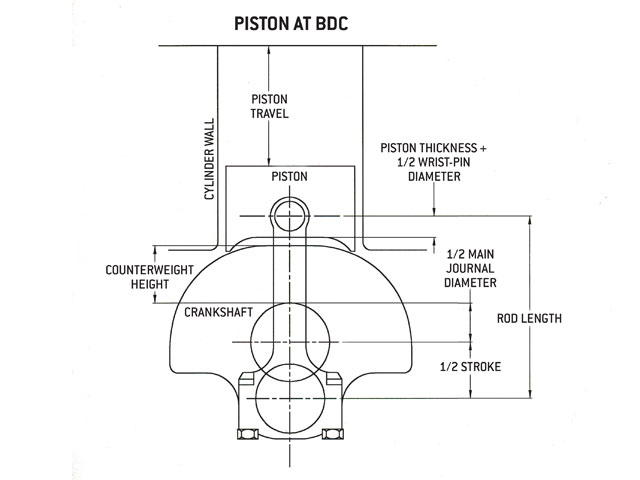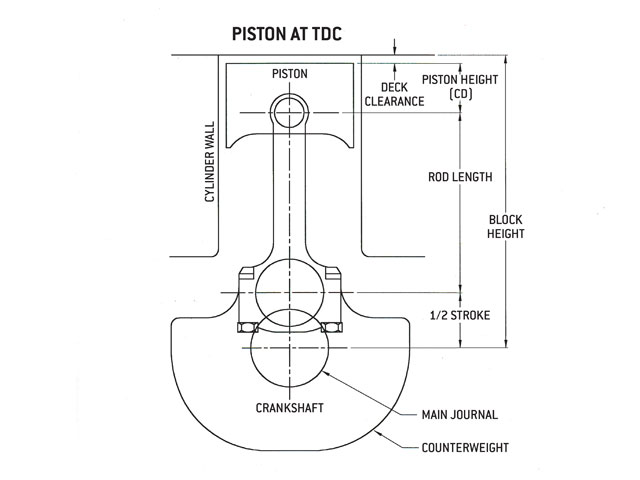"IM building a 496 stroker from my 454 engine in the corvette, I read somewhere that the 4.25 stroke of this engine will boost the compression a little more than the standard 4.00 stroke. Is that true? I thought that if I used the 10-1 pistons that are MADE to be used with the 6.385 rods, my compression would be the stated 10-1. Any thoughts? "
read this also
viewtopic.php?f=44&t=38&p=46#p46
http://kb-silvolite.com/article.php?action=read&A_id=36
first Id point out that your comparing apples & oranges too some extent, if you had flat top pistons designed for either engine with the came deck height, valve notches,etc, but the correct pin height for the application, or for that matter any pistons with identical dome displacement, and you use the same cylinder heads with the same combustion chamber size, increasing the stroke will increase the compression simply because youve increased the sweep voluum between bdc and tdc, play with this calc, change only the stroke on any combo and look over the results
http://www.csgnetwork.com/compcalc.html
now once you understand that approach, BUT you need to understand that the compression and dome height IS by design DIFFERENT on the 10:1 pistons for a 4" stroke and a 4.25" stroke piston designed to have 10:1 compression.
both will have approximately 10:1 cpr in thier intended application, but the pin height, piston dome cc ETC. will differ a great deal, if the compression ratio is designed to stay at the same 10:1 ratio
now it may help if you play with these calculators (below)
http://www.projectpontiac.com/ppsite/co ... iew/16/30/
http://kb-silvolite.com/calc.php?action=piston_comp
http://kb-silvolite.com/calc.php?action=deck
http://kb-silvolite.com/calc.php?action=piston
http://kb-silvolite.com/calc.php?action=comp2
keep in mind the blocks deck and crank centerline stay constant
if the blocks deck is 9.8" from the crank centerline and you have a 4.0" stroke with a 6.135" rod youll need a 1.665" pin height in the piston
if the blocks deck is 9.8" from the crank centerline and you have a 4.25" stroke with a 6.385" rod youll need a 1.29" pin height in the piston
http://www.hotrod.com/articles/1206phr-383ci-small-block-chevy/
http://www.superchevy.com/how-to/76178-chevrolet-ht-383-engine/
http://www.enginelabs.com/news/dyno-video-qmp-builds-500-horse-383-stroker/
http://www.chevyhardcore.com/tech-stories/engine/building-the-little-383-small-block-that-could/
http://royalpurpleconsumer.com/wp-c...-block-in-six-easy-steps-hot-rod-magazine.pdf
read this also
viewtopic.php?f=44&t=38&p=46#p46
http://kb-silvolite.com/article.php?action=read&A_id=36
first Id point out that your comparing apples & oranges too some extent, if you had flat top pistons designed for either engine with the came deck height, valve notches,etc, but the correct pin height for the application, or for that matter any pistons with identical dome displacement, and you use the same cylinder heads with the same combustion chamber size, increasing the stroke will increase the compression simply because youve increased the sweep voluum between bdc and tdc, play with this calc, change only the stroke on any combo and look over the results
http://www.csgnetwork.com/compcalc.html
now once you understand that approach, BUT you need to understand that the compression and dome height IS by design DIFFERENT on the 10:1 pistons for a 4" stroke and a 4.25" stroke piston designed to have 10:1 compression.
both will have approximately 10:1 cpr in thier intended application, but the pin height, piston dome cc ETC. will differ a great deal, if the compression ratio is designed to stay at the same 10:1 ratio
now it may help if you play with these calculators (below)
http://www.projectpontiac.com/ppsite/co ... iew/16/30/
http://kb-silvolite.com/calc.php?action=piston_comp
http://kb-silvolite.com/calc.php?action=deck
http://kb-silvolite.com/calc.php?action=piston
http://kb-silvolite.com/calc.php?action=comp2
keep in mind the blocks deck and crank centerline stay constant
if the blocks deck is 9.8" from the crank centerline and you have a 4.0" stroke with a 6.135" rod youll need a 1.665" pin height in the piston
if the blocks deck is 9.8" from the crank centerline and you have a 4.25" stroke with a 6.385" rod youll need a 1.29" pin height in the piston
http://www.hotrod.com/articles/1206phr-383ci-small-block-chevy/
http://www.superchevy.com/how-to/76178-chevrolet-ht-383-engine/
http://www.enginelabs.com/news/dyno-video-qmp-builds-500-horse-383-stroker/
http://www.chevyhardcore.com/tech-stories/engine/building-the-little-383-small-block-that-could/
http://royalpurpleconsumer.com/wp-c...-block-in-six-easy-steps-hot-rod-magazine.pdf
Last edited by a moderator:



